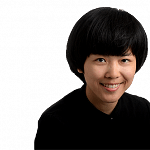A Singapore artist who took a blood oath last Friday to express his disappointment at not being able to perform his work in the Singapore Biennale had originally been amenable to its presentation as a static display of an intended performance piece, says the biennale's organiser, the Singapore Art Museum.
The work, Unwalked Boundaries, by multidisciplinary artist S. Chandrasekaran is presented in the biennale, which opened last Thursday, as an installation of materials for a performance piece he had intended to carry out - a walk in the Bras Basah-Bugis area to remember the forgotten stories of Indian convicts who were transported to British colonial Singapore in the 1800s to serve their sentence as manual labourers, constructing, among other things, buildings in the Bras Basah area.
The 57-year-old artist had intended to walk with pieces of ice attached to his body using hooks and wearing a metal headband inscribed with his identity card number, to personify and pay homage to the 19th-century Indian convicts.
The installation exhibited at the Singapore Art Museum's annexe building in Queen Street includes the metal headband, a set of six hooks and a map of the walking route etched onto ceramic slabs.
Chandrasekaran was among a longlist of artists whom the biennale's curators had invited to submit a proposal for the exhibition because their artistic practice resonated with the biennale's explorations of the complex social, political, geographical and historical relationships shared by people and places in Asia.
The artist is known for performances that test the physical limits of the body to raise questions about an individual's ethnic, religious and national identity.
The museum's head of marketing communications and international relations, Ms Lynn Sim, told The Straits Times that the artist first sent in a proposal in March that later evolved into the intended performance, which was submitted in May.
The biennale's associate curator Michael Lee, who curated the artist's work, said: "During our conversations, we realised that his proposed performance may be perceived as resembling religious rituals such as the Thaipusam, so we gave the artist feedback that this might be taken as offensive by certain segments of the community."
Ms Sim said the biennale curatorial team had consulted the biennale's advisory committee, which includes eminent Singapore curators T.K. Sabapathy, June Yap and Ahmad Mashadi; and, separately, the Ministry of Culture, Community and Youth, whose Hindu Advisory Board gave feedback about the religious sensitivities of the proposed artwork.
She said that when the feedback was shared with the artist at a meeting on July 4, as part of the curatorial process where the biennale's curators discuss with participating artists how best to present their works in the show, he "initially felt that he did not want to adapt the artwork any further" and said that he may consider withdrawing from the show.
However, after further discussions at the same meeting with the biennale's curators and creative director, Dr Susie Lingham, "the artist expressed that he was amenable to the development of an alternative artwork proposal for the biennale that would still address the original artwork's subject matter and also maintain the concept of the initial work", said Ms Sim.
He submitted the revised proposal for Unwalked Boundaries on July 7.
Mr Lee said: "My curatorial process with Chandra(sekaran) has been enriching and enjoyable as we worked together with the rest of the curatorial team to explore ways to present his idea with conceptual integrity."
However, at the biennale's opening weekend artist talks where artists share informally with visitors in the galleries about their works, Chandrasekaran took a blood oath.
A report by Today newspaper quoted the artist as saying: "I'm making a blood oath today, that I will never perform in Singapore until this is performed. And every day I will mark my skin, a scar, until I (get to) perform. This is my oath."
Ms Sim said the museum's staff offered the artist first aid to stop the bleeding, but he refused help.
When asked by The Straits Times if he has continued to abide by the oath he took, he declined to comment. He also did not respond to questions about the curatorial process or why he chose to take a blood oath at the artist talk.
Ms Sim said the biennale's curators reached out to the artist after his talk to have a discussion and a meeting is scheduled for Thursday.

